2001 CHRYSLER VOYAGER engine coolant
[x] Cancel search: engine coolantPage 1227 of 4284
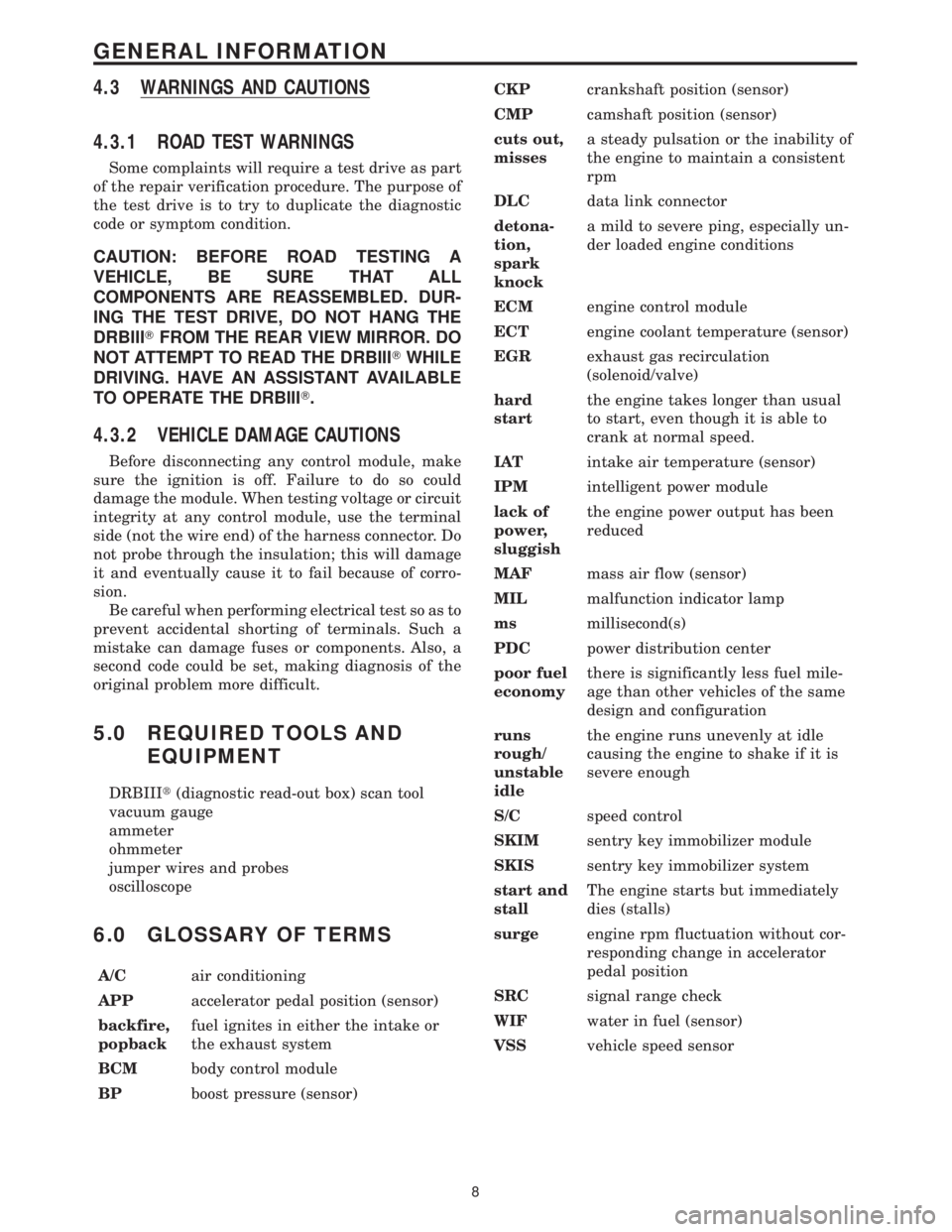
4.3 WARNINGS AND CAUTIONS
4.3.1 ROAD TEST WARNINGS
Some complaints will require a test drive as part
of the repair verification procedure. The purpose of
the test drive is to try to duplicate the diagnostic
code or symptom condition.
CAUTION: BEFORE ROAD TESTING A
VEHICLE, BE SURE THAT ALL
COMPONENTS ARE REASSEMBLED. DUR-
ING THE TEST DRIVE, DO NOT HANG THE
DRBIIITFROM THE REAR VIEW MIRROR. DO
NOT ATTEMPT TO READ THE DRBIIITWHILE
DRIVING. HAVE AN ASSISTANT AVAILABLE
TO OPERATE THE DRBIIIT.
4.3.2 VEHICLE DAMAGE CAUTIONS
Before disconnecting any control module, make
sure the ignition is off. Failure to do so could
damage the module. When testing voltage or circuit
integrity at any control module, use the terminal
side (not the wire end) of the harness connector. Do
not probe through the insulation; this will damage
it and eventually cause it to fail because of corro-
sion.
Be careful when performing electrical test so as to
prevent accidental shorting of terminals. Such a
mistake can damage fuses or components. Also, a
second code could be set, making diagnosis of the
original problem more difficult.
5.0 REQUIRED TOOLS AND
EQUIPMENT
DRBIIIt(diagnostic read-out box) scan tool
vacuum gauge
ammeter
ohmmeter
jumper wires and probes
oscilloscope
6.0 GLOSSARY OF TERMS
A/Cair conditioning
APPaccelerator pedal position (sensor)
backfire,
popbackfuel ignites in either the intake or
the exhaust system
BCMbody control module
BPboost pressure (sensor)CKPcrankshaft position (sensor)
CMPcamshaft position (sensor)
cuts out,
missesa steady pulsation or the inability of
the engine to maintain a consistent
rpm
DLCdata link connector
detona-
tion,
spark
knocka mild to severe ping, especially un-
der loaded engine conditions
ECMengine control module
ECTengine coolant temperature (sensor)
EGRexhaust gas recirculation
(solenoid/valve)
hard
startthe engine takes longer than usual
to start, even though it is able to
crank at normal speed.
IATintake air temperature (sensor)
IPMintelligent power module
lack of
power,
sluggishthe engine power output has been
reduced
MAFmass air flow (sensor)
MILmalfunction indicator lamp
msmillisecond(s)
PDCpower distribution center
poor fuel
economythere is significantly less fuel mile-
age than other vehicles of the same
design and configuration
runs
rough/
unstable
idlethe engine runs unevenly at idle
causing the engine to shake if it is
severe enough
S/Cspeed control
SKIMsentry key immobilizer module
SKISsentry key immobilizer system
start and
stallThe engine starts but immediately
dies (stalls)
surgeengine rpm fluctuation without cor-
responding change in accelerator
pedal position
SRCsignal range check
WIFwater in fuel (sensor)
VSSvehicle speed sensor
8
GENERAL INFORMATION
Page 1248 of 4284
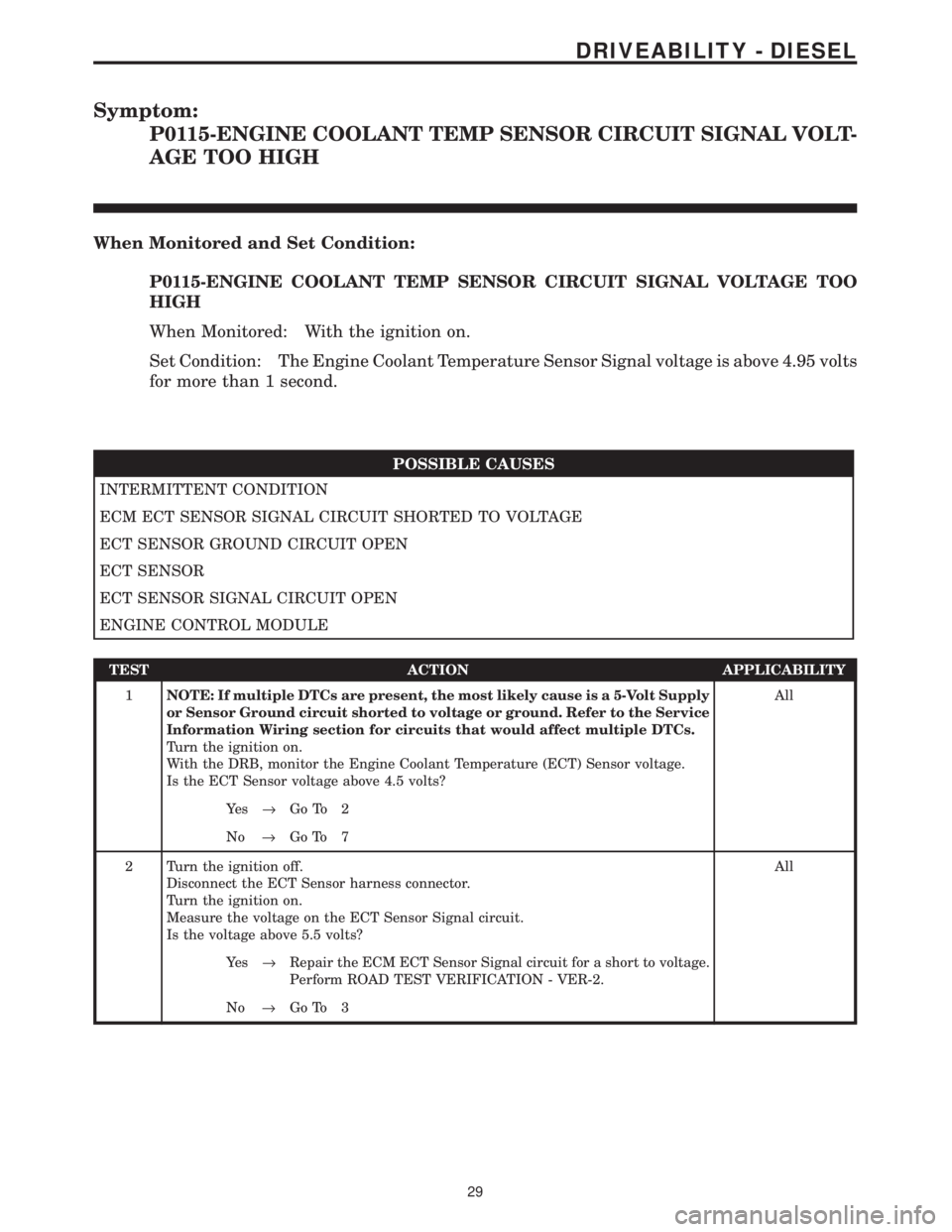
Symptom:
P0115-ENGINE COOLANT TEMP SENSOR CIRCUIT SIGNAL VOLT-
AGE TOO HIGH
When Monitored and Set Condition:
P0115-ENGINE COOLANT TEMP SENSOR CIRCUIT SIGNAL VOLTAGE TOO
HIGH
When Monitored: With the ignition on.
Set Condition: The Engine Coolant Temperature Sensor Signal voltage is above 4.95 volts
for more than 1 second.
POSSIBLE CAUSES
INTERMITTENT CONDITION
ECM ECT SENSOR SIGNAL CIRCUIT SHORTED TO VOLTAGE
ECT SENSOR GROUND CIRCUIT OPEN
ECT SENSOR
ECT SENSOR SIGNAL CIRCUIT OPEN
ENGINE CONTROL MODULE
TEST ACTION APPLICABILITY
1NOTE: If multiple DTCs are present, the most likely cause is a 5-Volt Supply
or Sensor Ground circuit shorted to voltage or ground. Refer to the Service
Information Wiring section for circuits that would affect multiple DTCs.
Turn the ignition on.
With the DRB, monitor the Engine Coolant Temperature (ECT) Sensor voltage.
Is the ECT Sensor voltage above 4.5 volts?All
Ye s®Go To 2
No®Go To 7
2 Turn the ignition off.
Disconnect the ECT Sensor harness connector.
Turn the ignition on.
Measure the voltage on the ECT Sensor Signal circuit.
Is the voltage above 5.5 volts?All
Ye s®Repair the ECM ECT Sensor Signal circuit for a short to voltage.
Perform ROAD TEST VERIFICATION - VER-2.
No®Go To 3
29
DRIVEABILITY - DIESEL
Page 1249 of 4284
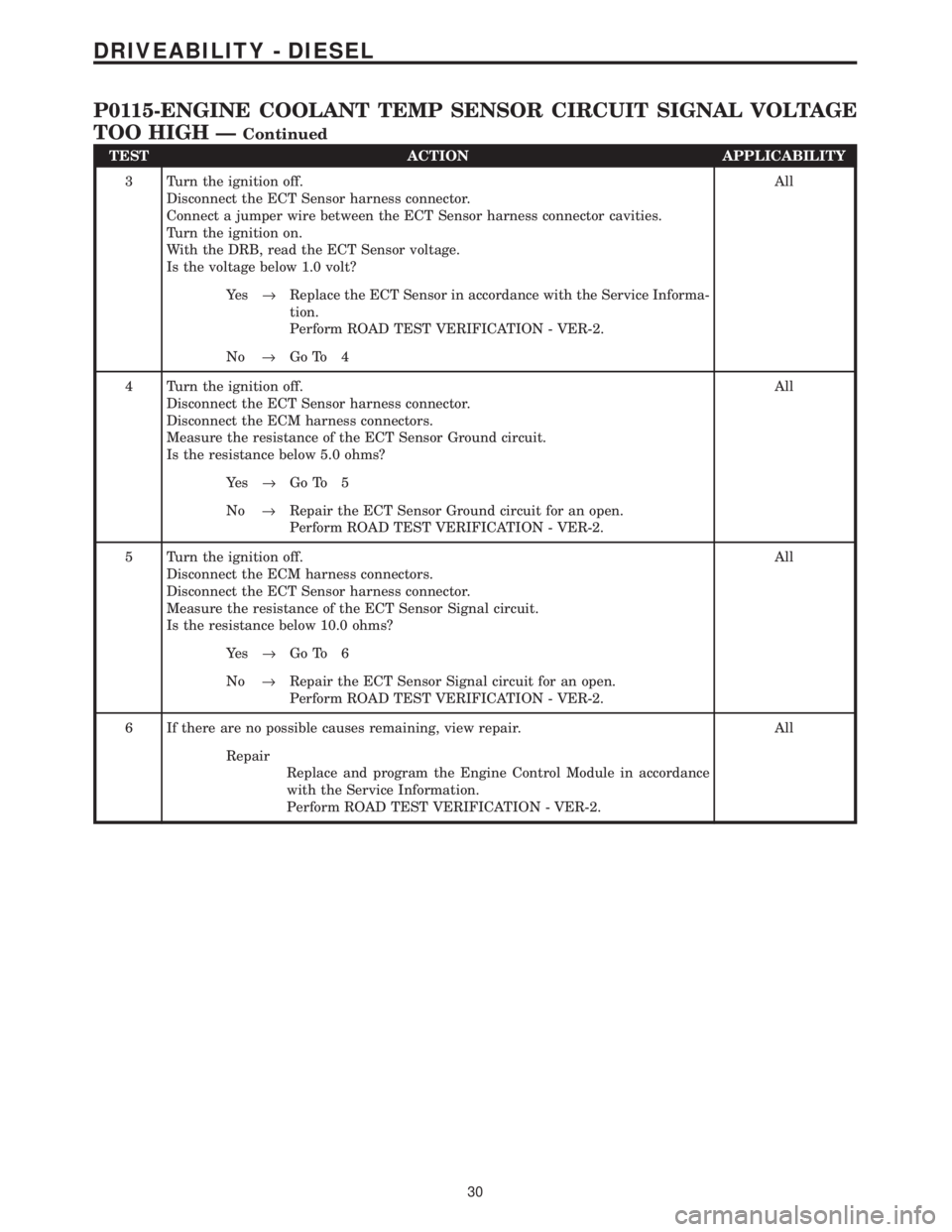
TEST ACTION APPLICABILITY
3 Turn the ignition off.
Disconnect the ECT Sensor harness connector.
Connect a jumper wire between the ECT Sensor harness connector cavities.
Turn the ignition on.
With the DRB, read the ECT Sensor voltage.
Is the voltage below 1.0 volt?All
Ye s®Replace the ECT Sensor in accordance with the Service Informa-
tion.
Perform ROAD TEST VERIFICATION - VER-2.
No®Go To 4
4 Turn the ignition off.
Disconnect the ECT Sensor harness connector.
Disconnect the ECM harness connectors.
Measure the resistance of the ECT Sensor Ground circuit.
Is the resistance below 5.0 ohms?All
Ye s®Go To 5
No®Repair the ECT Sensor Ground circuit for an open.
Perform ROAD TEST VERIFICATION - VER-2.
5 Turn the ignition off.
Disconnect the ECM harness connectors.
Disconnect the ECT Sensor harness connector.
Measure the resistance of the ECT Sensor Signal circuit.
Is the resistance below 10.0 ohms?All
Ye s®Go To 6
No®Repair the ECT Sensor Signal circuit for an open.
Perform ROAD TEST VERIFICATION - VER-2.
6 If there are no possible causes remaining, view repair. All
Repair
Replace and program the Engine Control Module in accordance
with the Service Information.
Perform ROAD TEST VERIFICATION - VER-2.
30
DRIVEABILITY - DIESEL
P0115-ENGINE COOLANT TEMP SENSOR CIRCUIT SIGNAL VOLTAGE
TOO HIGH Ð
Continued
Page 1250 of 4284

TEST ACTION APPLICABILITY
7WARNING: WHEN THE ENGINE IS OPERATING, DO NOT STAND IN A
DIRECT LINE WITH THE FAN. DO NOT PUT YOUR HANDS NEAR THE
PULLEYS, BELTS OR FAN. DO NOT WEAR LOOSE CLOTHING.
NOTE: The conditions that set the DTC are not present at this time. The
following list may help in identifying the intermittent condition.
With the engine running at normal operating temperature, monitor the DRB
parameters related to the DTC while wiggling the wiring harness. Look for param-
eter values to change and/or a DTC to set.
Review the DTC When Monitored and Set Conditions. If possible, try to duplicate the
conditions under which the DTC was set.
Refer to any Technical Service Bulletins (TSB) that may apply.
Visually inspect the related wiring harness. Look for any chafed, pierced, pinched, or
partially broken wires.
Visually inspect the related wiring harness connectors. Look for broken, bent, pushed
out, or corroded terminals.
Were any of the above conditions present?All
Ye s®Repair as necessary.
Perform ROAD TEST VERIFICATION - VER-2.
No®Test Complete.
31
DRIVEABILITY - DIESEL
P0115-ENGINE COOLANT TEMP SENSOR CIRCUIT SIGNAL VOLTAGE
TOO HIGH Ð
Continued
Page 1251 of 4284

Symptom:
P0115-ENGINE COOLANT TEMP SENSOR CIRCUIT SIGNAL VOLT-
AGE TOO LOW
When Monitored and Set Condition:
P0115-ENGINE COOLANT TEMP SENSOR CIRCUIT SIGNAL VOLTAGE TOO
LOW
When Monitored: With the ignition on.
Set Condition: The Engine Coolant Temperature Sensor Signal voltage is below 0.2 volt
for more than 1 second.
POSSIBLE CAUSES
INTERMITTENT CONDITION
ECT SENSOR
ECT SENSOR SIGNAL CIRCUIT SHORTED TO GROUND
ECT SENSOR SIGNAL AND GROUND CIRCUITS SHORTED TOGETHER
ENGINE CONTROL MODULE
TEST ACTION APPLICABILITY
1 Turn the ignition on.
With the DRB, monitor the Engine Coolant Temperature (ECT) Sensor voltage.
Is the ECT Sensor voltage below 0.3 volt?All
Ye s®Go To 2
No®Go To 6
2 Turn the ignition off.
Disconnect the ECT Sensor harness connector.
Turn the ignition on.
With the DRB, read the ECT Sensor voltage.
Is the voltage above 4.0 volts?All
Ye s®Replace the ECT Sensor in accordance with the Service Informa-
tion.
Perform ROAD TEST VERIFICATION - VER-2.
No®Go To 3
3 Turn the ignition off.
Disconnect the ECM harness connectors.
Disconnect the ECT Sensor harness connector.
Measure the resistance between ground and the ECT Sensor Signal circuit.
Is the resistance above 1000 ohms?All
Ye s®Go To 4
No®Repair the ECT Sensor Signal circuit for a short to ground.
Perform ROAD TEST VERIFICATION - VER-2.
32
DRIVEABILITY - DIESEL
Page 1252 of 4284
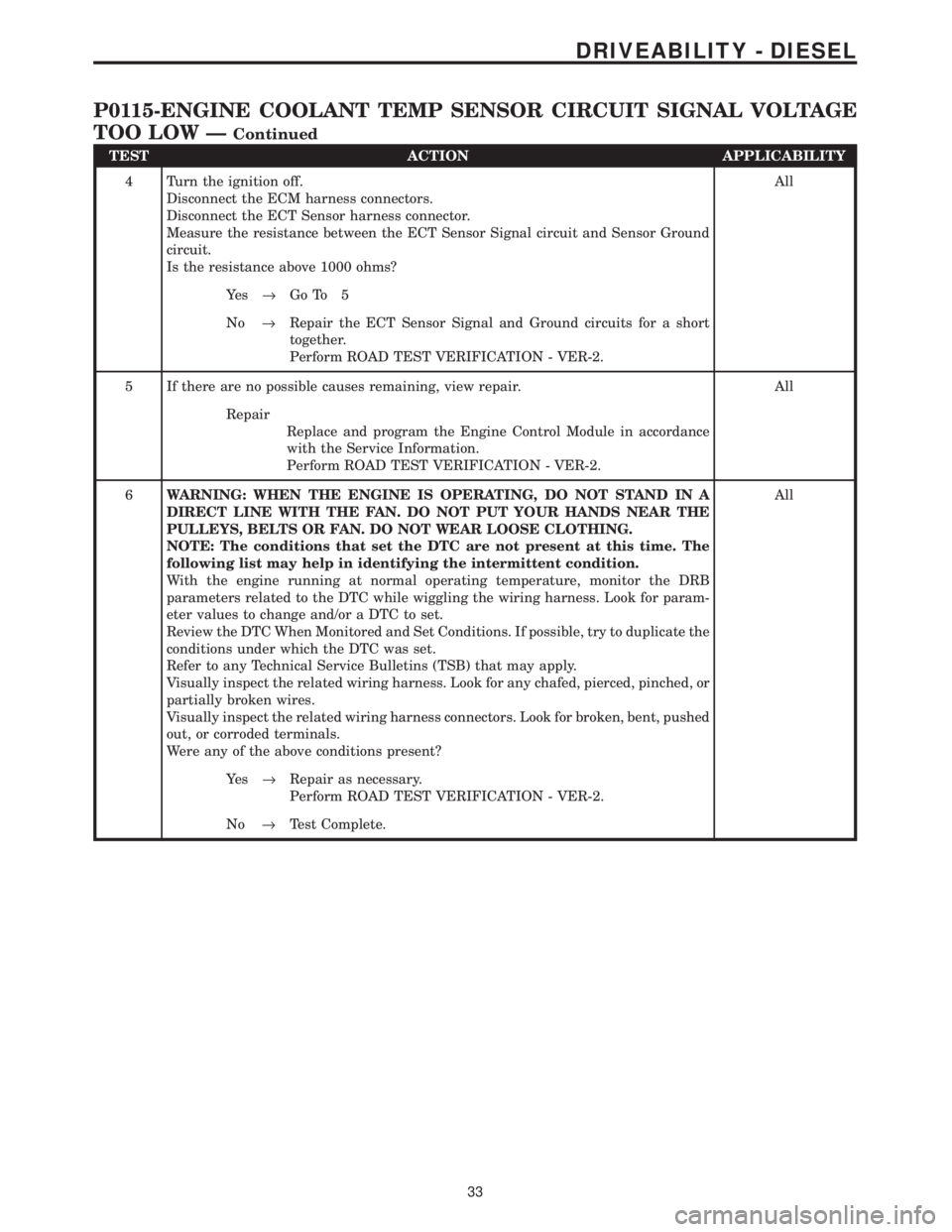
TEST ACTION APPLICABILITY
4 Turn the ignition off.
Disconnect the ECM harness connectors.
Disconnect the ECT Sensor harness connector.
Measure the resistance between the ECT Sensor Signal circuit and Sensor Ground
circuit.
Is the resistance above 1000 ohms?All
Ye s®Go To 5
No®Repair the ECT Sensor Signal and Ground circuits for a short
together.
Perform ROAD TEST VERIFICATION - VER-2.
5 If there are no possible causes remaining, view repair. All
Repair
Replace and program the Engine Control Module in accordance
with the Service Information.
Perform ROAD TEST VERIFICATION - VER-2.
6WARNING: WHEN THE ENGINE IS OPERATING, DO NOT STAND IN A
DIRECT LINE WITH THE FAN. DO NOT PUT YOUR HANDS NEAR THE
PULLEYS, BELTS OR FAN. DO NOT WEAR LOOSE CLOTHING.
NOTE: The conditions that set the DTC are not present at this time. The
following list may help in identifying the intermittent condition.
With the engine running at normal operating temperature, monitor the DRB
parameters related to the DTC while wiggling the wiring harness. Look for param-
eter values to change and/or a DTC to set.
Review the DTC When Monitored and Set Conditions. If possible, try to duplicate the
conditions under which the DTC was set.
Refer to any Technical Service Bulletins (TSB) that may apply.
Visually inspect the related wiring harness. Look for any chafed, pierced, pinched, or
partially broken wires.
Visually inspect the related wiring harness connectors. Look for broken, bent, pushed
out, or corroded terminals.
Were any of the above conditions present?All
Ye s®Repair as necessary.
Perform ROAD TEST VERIFICATION - VER-2.
No®Test Complete.
33
DRIVEABILITY - DIESEL
P0115-ENGINE COOLANT TEMP SENSOR CIRCUIT SIGNAL VOLTAGE
TOO LOW Ð
Continued
Page 1412 of 4284
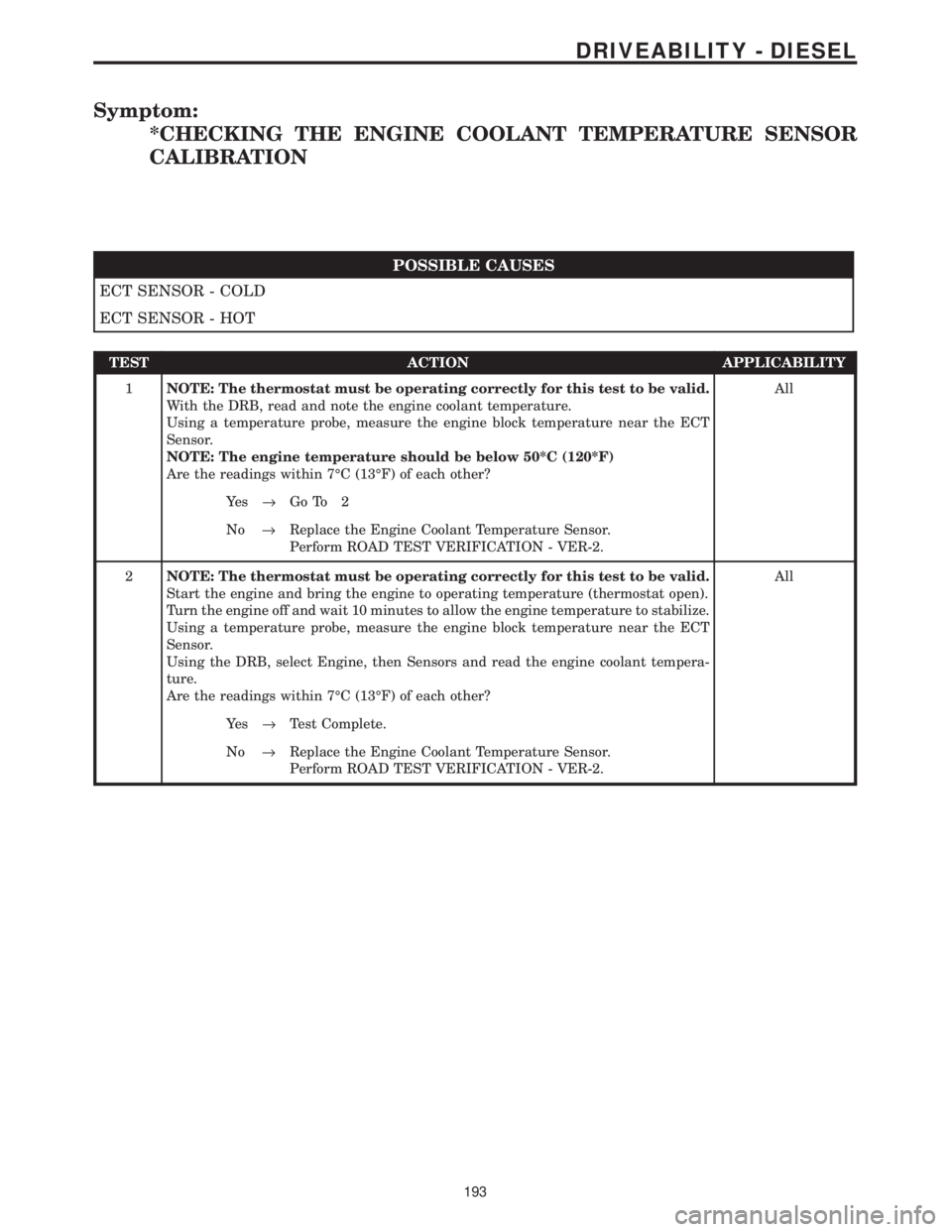
Symptom:
*CHECKING THE ENGINE COOLANT TEMPERATURE SENSOR
CALIBRATION
POSSIBLE CAUSES
ECT SENSOR - COLD
ECT SENSOR - HOT
TEST ACTION APPLICABILITY
1NOTE: The thermostat must be operating correctly for this test to be valid.
With the DRB, read and note the engine coolant temperature.
Using a temperature probe, measure the engine block temperature near the ECT
Sensor.
NOTE: The engine temperature should be below 50*C (120*F)
Are the readings within 7ÉC (13ÉF) of each other?All
Ye s®Go To 2
No®Replace the Engine Coolant Temperature Sensor.
Perform ROAD TEST VERIFICATION - VER-2.
2NOTE: The thermostat must be operating correctly for this test to be valid.
Start the engine and bring the engine to operating temperature (thermostat open).
Turn the engine off and wait 10 minutes to allow the engine temperature to stabilize.
Using a temperature probe, measure the engine block temperature near the ECT
Sensor.
Using the DRB, select Engine, then Sensors and read the engine coolant tempera-
ture.
Are the readings within 7ÉC (13ÉF) of each other?All
Ye s®Test Complete.
No®Replace the Engine Coolant Temperature Sensor.
Perform ROAD TEST VERIFICATION - VER-2.
193
DRIVEABILITY - DIESEL
Page 1453 of 4284
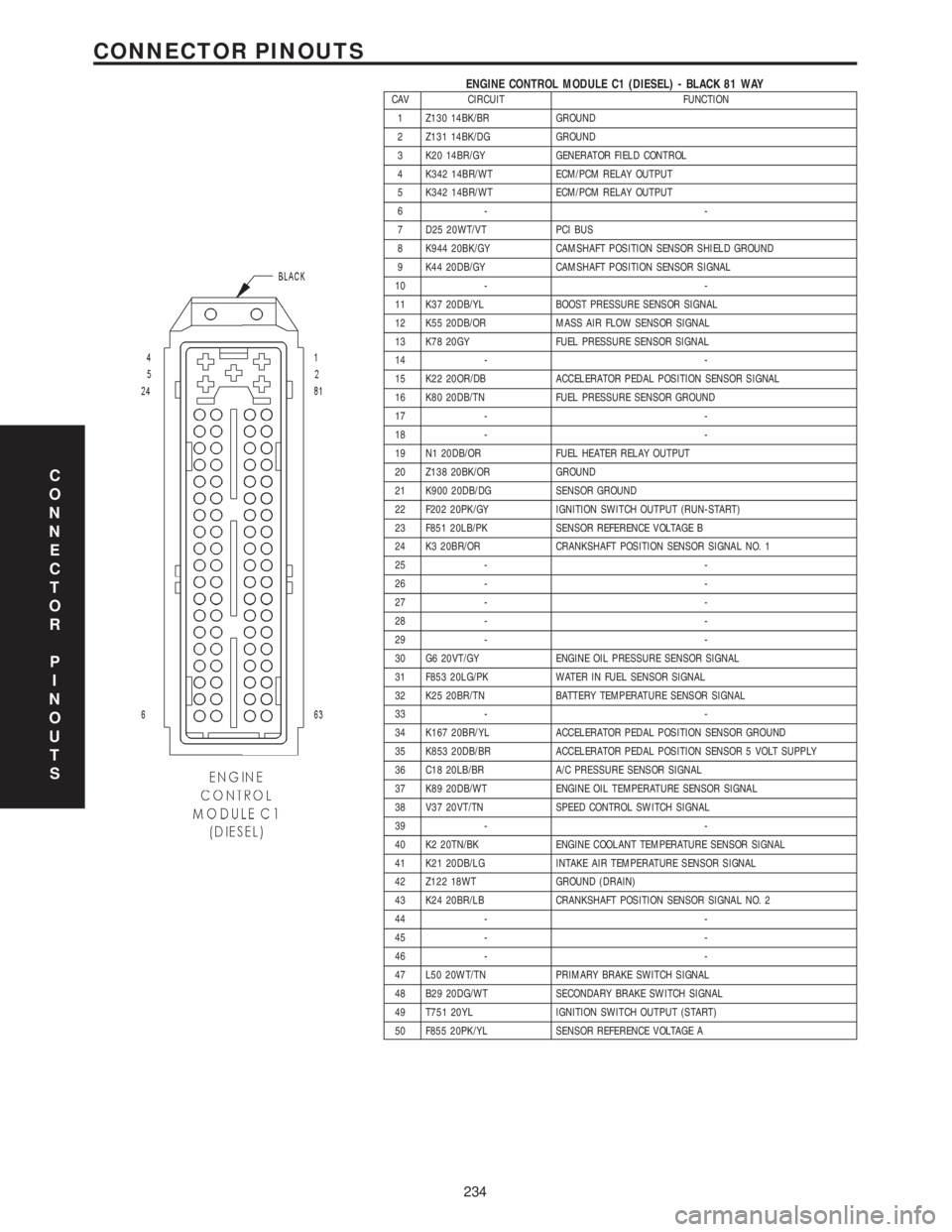
ENGINE CONTROL MODULE C1 (DIESEL) - BLACK 81 WAYCAV CIRCUIT FUNCTION
1 Z130 14BK/BR GROUND
2 Z131 14BK/DG GROUND
3 K20 14BR/GY GENERATOR FIELD CONTROL
4 K342 14BR/WT ECM/PCM RELAY OUTPUT
5 K342 14BR/WT ECM/PCM RELAY OUTPUT
6- -
7 D25 20WT/VT PCI BUS
8 K944 20BK/GY CAMSHAFT POSITION SENSOR SHIELD GROUND
9 K44 20DB/GY CAMSHAFT POSITION SENSOR SIGNAL
10 - -
11 K37 20DB/YL BOOST PRESSURE SENSOR SIGNAL
12 K55 20DB/OR MASS AIR FLOW SENSOR SIGNAL
13 K78 20GY FUEL PRESSURE SENSOR SIGNAL
14 - -
15 K22 20OR/DB ACCELERATOR PEDAL POSITION SENSOR SIGNAL
16 K80 20DB/TN FUEL PRESSURE SENSOR GROUND
17 - -
18 - -
19 N1 20DB/OR FUEL HEATER RELAY OUTPUT
20 Z138 20BK/OR GROUND
21 K900 20DB/DG SENSOR GROUND
22 F202 20PK/GY IGNITION SWITCH OUTPUT (RUN-START)
23 F851 20LB/PK SENSOR REFERENCE VOLTAGE B
24 K3 20BR/OR CRANKSHAFT POSITION SENSOR SIGNAL NO. 1
25 - -
26 - -
27 - -
28 - -
29 - -
30 G6 20VT/GY ENGINE OIL PRESSURE SENSOR SIGNAL
31 F853 20LG/PK WATER IN FUEL SENSOR SIGNAL
32 K25 20BR/TN BATTERY TEMPERATURE SENSOR SIGNAL
33 - -
34 K167 20BR/YL ACCELERATOR PEDAL POSITION SENSOR GROUND
35 K853 20DB/BR ACCELERATOR PEDAL POSITION SENSOR 5 VOLT SUPPLY
36 C18 20LB/BR A/C PRESSURE SENSOR SIGNAL
37 K89 20DB/WT ENGINE OIL TEMPERATURE SENSOR SIGNAL
38 V37 20VT/TN SPEED CONTROL SWITCH SIGNAL
39 - -
40 K2 20TN/BK ENGINE COOLANT TEMPERATURE SENSOR SIGNAL
41 K21 20DB/LG INTAKE AIR TEMPERATURE SENSOR SIGNAL
42 Z122 18WT GROUND (DRAIN)
43 K24 20BR/LB CRANKSHAFT POSITION SENSOR SIGNAL NO. 2
44 - -
45 - -
46 - -
47 L50 20WT/TN PRIMARY BRAKE SWITCH SIGNAL
48 B29 20DG/WT SECONDARY BRAKE SWITCH SIGNAL
49 T751 20YL IGNITION SWITCH OUTPUT (START)
50 F855 20PK/YL SENSOR REFERENCE VOLTAGE A
C
O
N
N
E
C
T
O
R
P
I
N
O
U
T
S
234
CONNECTOR PINOUTS